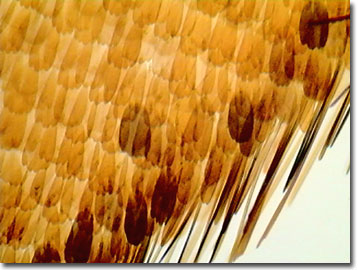Butterfly Wing Scale Digital Image Gallery
Cruiser Butterfly
There are at least thirteen known subspecies of the Indo-Australian cruiser butterfly, several of which are restricted to a single island in the Pacific Ocean. As their name indicates, cruiser butterflies are strong and lofty fliers. Male members of the species are most often observed cruising along forest roads and edge habitat, but females often soar to great heights, sometimes laying eggs as high as 1,800 meters in the tropical rainforest canopy.

The cruiser butterfly is a medium-sized lepidopteran in the family Nymphalidae, which includes the emperor, admiral, tortoiseshell, and fritillary butterflies. Members of the species have a highly modified front pair of legs and possess wingspans 70 to 100 millimeters wide. The wing upper sides of female cruisers are colored a burnt orange and black. Males, however, tend to be lighter and more yellow. Cruiser butterflies are scientifically known as Vindula erota, but are commonly called banded treebrown butterflies in Thailand. The name stems from the cryptic undersides of their wings, which are brown and offer camouflage in dried foliage.
Cruiser larvae feed on the leaves of plants in the family Passifloraceae, which includes the passion vines and passionflowers. Their favorite seems to be the succulent Adenia, known for its poisonous sap and wine bottle-shaped swollen stems. The fleshy larvae are primarily gray, are sparsely covered with spines, and feature a prominent black horned mask. The cruiser pupa maintains the subdued coloration of the caterpillar. The chrysalis can easily pass as a leaf skeleton due to its lengthy and curiously shaped appendages that correspond to a decaying leaf's ribs or veins.
Local populations of cruiser butterflies, particularly on smaller islands, are strained. Collection pressures accompanied by human encroachment, pesticide use, and habitat destruction have been a heavy burden on the butterfly species. Historic and modern wars have also taken their toll on the lepidopterans. An optimistic sign for the cruiser butterfly does exist, however. The species is often touted in ecotourism advertisements for butterfly watching safaris in India, Southeast Asia and the Malaysian Archipelago, and is featured at many educational butterfly conservatories in North America and Europe.
Cruiser Butterfly Images in Brightfield Illumination
Wing Scale Array - This high magnification of a cruiser butterfly's wing scales clearly displays their scalloped edges. Brightfield illumination also provides detail regarding the overlapping pattern of the scales.
Cruiser Butterfly Images in Darkfield Illumination
Wing Scale Interference Patterns - In this darkfield image, numerous striations appear on each tiny scale. The phenomenon is caused by illumination interference.
Fur on Wing - This image is a beautiful example of the fur that covers the wings of cruiser butterflies. The straw-like fur is so abundant that it veils a large number of wing scales.
Cruiser Butterfly Images in Oblique Illumination
Wing Scales and Fur - Numerous overlapping scales and a covering of fur can be seen in this oblique light image of a cruiser butterfly's wing. Although they appear delicate, the wings of the species are strong enough for them to soar to great heights.
Contributing Authors
Cynthia D. Kelly, Shannon H. Neaves, Laurence D. Zuckerman, and Michael W. Davidson - National High Magnetic Field Laboratory, 1800 East Paul Dirac Dr., The Florida State University, Tallahassee, Florida, 32310.
BACK TO THE BUTTERFLY WING SCALE IMAGE GALLERY
BACK TO THE DIGITAL IMAGE GALLERIES
Questions or comments? Send us an email.
© 1995-2025 by Michael W. Davidson and The Florida State University. All Rights Reserved. No images, graphics, software, scripts, or applets may be reproduced or used in any manner without permission from the copyright holders. Use of this website means you agree to all of the Legal Terms and Conditions set forth by the owners.
This website is maintained by our
Graphics & Web Programming Team
in collaboration with Optical Microscopy at the
National High Magnetic Field Laboratory.
Last Modification Friday, Nov 13, 2015 at 01:19 PM
Access Count Since January 21, 2003: 23966
Visit the website of our partner in introductory microscopy education:
|
|
